Rose Rasmalai, a symphony of flavors and textures, is about to become your new favorite dessert! Imagine delicate, spongy cheese patties, soaked in a creamy, rose-infused milk, each bite a burst of floral sweetness and milky goodness. Have you ever tasted something so divine that it felt like a warm hug on a cold day? That’s exactly what this dessert offers.
Rasmalai, in its original form, boasts a rich history rooted in the Indian subcontinent. Believed to have originated in Bengal, it was traditionally made with simple ingredients and flavors. Over time, regional variations emerged, and the addition of rose essence transformed it into the elegant and fragrant Rose Rasmalai we adore today. The rose not only adds a beautiful aroma but also lends a subtle, sophisticated flavor that elevates the entire experience.
People are captivated by Rose Rasmalai for several reasons. Firstly, the taste is simply irresistible the combination of milky sweetness, the delicate chewiness of the cheese patties, and the enchanting rose flavor creates a harmonious blend that dances on your palate. Secondly, it’s a visually stunning dessert, perfect for special occasions or simply to brighten up your day. Finally, while it may seem intricate, making Rose Rasmalai at home is surprisingly achievable with the right guidance. So, are you ready to embark on this culinary adventure with me? Let’s create some magic in the kitchen!
Ingredients:
- For the Rasmalai Patties (Chhena):
- 4 cups whole milk (full-fat is best!)
- 2 tablespoons lemon juice or white vinegar (for curdling)
- 1/4 cup all-purpose flour (maida)
- 1/2 teaspoon baking powder
- For the Rabri (Sweetened Milk):
- 6 cups whole milk
- 1/2 cup granulated sugar (adjust to taste)
- 1/4 teaspoon cardamom powder
- A pinch of saffron strands (kesar)
- 1 tablespoon chopped pistachios (for garnish)
- 1 tablespoon chopped almonds (for garnish)
- 1 teaspoon rose water
- 1/4 cup rose syrup (Rooh Afza or similar)
- Edible rose petals (for garnish, optional)
- Equipment:
- Large pot
- Cheesecloth or muslin cloth
- Heavy-bottomed pan or kadhai
- Slotted spoon
Making the Chhena (Indian Cheese):
This is the foundation of our Rasmalai, so let’s get it right! Don’t be intimidated; it’s easier than you think.
- Curdling the Milk: Pour the 4 cups of whole milk into a large pot. Bring it to a boil over medium heat, stirring occasionally to prevent it from sticking to the bottom. Once the milk boils, reduce the heat to low.
- Adding the Acid: Gradually add the lemon juice or white vinegar, one tablespoon at a time, stirring gently after each addition. You’ll see the milk start to curdle and separate into solids (the chhena) and whey (the watery liquid). If it doesn’t curdle after 2 tablespoons, add a little more, but be careful not to add too much, as it can make the chhena tough.
- Separating the Chhena: Once the milk has completely curdled, remove the pot from the heat. Line a colander with cheesecloth or muslin cloth. Pour the curdled milk into the lined colander. This will separate the chhena from the whey.
- Washing the Chhena: Rinse the chhena under cold running water for a few minutes. This removes the sour taste of the lemon juice or vinegar and helps to stop the cooking process.
- Removing Excess Water: Gather the edges of the cheesecloth and squeeze out as much excess water as possible. Then, tie the cheesecloth into a bundle and hang it over a sink or bowl for about 30-45 minutes to drain completely. This is crucial for getting the right texture. You want the chhena to be moist but not wet.
- Kneading the Chhena: Once the chhena has drained, transfer it to a clean, flat surface. Now comes the important part: kneading! Use the heel of your hand to knead the chhena for about 8-10 minutes, until it becomes smooth and lump-free. This step is essential for making soft and spongy Rasmalai patties. If the chhena is too dry, sprinkle a little milk over it while kneading.
- Adding Flour and Baking Powder: Add the all-purpose flour (maida) and baking powder to the kneaded chhena. Mix well and knead again for another 2-3 minutes until everything is combined into a smooth dough.
Shaping and Cooking the Rasmalai Patties:
Now that we have our perfect chhena dough, let’s shape those patties and cook them to perfection!
- Shaping the Patties: Divide the chhena dough into 12-15 equal portions. Roll each portion into a smooth ball and then gently flatten it into a disc shape, about 1-1.5 inches in diameter. Make sure the edges are smooth to prevent them from cracking during cooking.
- Preparing the Sugar Syrup: In a wide, heavy-bottomed pan or kadhai, combine 4 cups of water and 1 cup of granulated sugar. Bring the mixture to a boil over medium heat, stirring until the sugar dissolves completely.
- Cooking the Patties: Once the sugar syrup is boiling, gently drop the chhena patties into the syrup, one at a time. Make sure not to overcrowd the pan. Cover the pan and cook the patties for about 15-20 minutes on medium heat. The patties will puff up and almost double in size.
- Checking for Doneness: After 15-20 minutes, gently check if the patties are cooked through. They should be soft and spongy. If they still seem dense, cook for a few more minutes.
- Cooling the Patties: Once the patties are cooked, turn off the heat and let them cool in the sugar syrup for at least 30 minutes. This allows them to absorb the syrup and become even softer.
- Gently Pressing the Patties: After cooling, gently press each patty between your palms to remove excess sugar syrup. Be careful not to squeeze them too hard, as they are delicate.
Making the Rose-Infused Rabri:
This is where the magic happens! We’ll transform simple milk into a rich, flavorful rabri with a beautiful rose essence.
- Boiling the Milk: In a heavy-bottomed pan, pour the 6 cups of whole milk. Bring it to a boil over medium heat, stirring frequently to prevent it from sticking to the bottom.
- Simmering and Reducing: Once the milk boils, reduce the heat to low and let it simmer for about 45-60 minutes, or until it reduces to about half its original volume. Keep stirring occasionally to prevent it from sticking and to scrape off the milk solids that form on the sides of the pan. These milk solids are what give the rabri its rich texture.
- Adding Sugar and Cardamom: After the milk has reduced, add the 1/2 cup of granulated sugar and 1/4 teaspoon of cardamom powder. Stir well until the sugar dissolves completely.
- Adding Saffron and Rose Syrup: Add a pinch of saffron strands and the 1/4 cup of rose syrup (Rooh Afza or similar) to the rabri. Stir gently to combine. The saffron will add a beautiful color and aroma, while the rose syrup will give it a lovely rose flavor.
- Adding Rose Water: Stir in 1 teaspoon of rose water.
- Simmering Further: Continue to simmer the rabri for another 10-15 minutes, stirring occasionally, until it thickens slightly. The consistency should be creamy and slightly coating.
- Cooling the Rabri: Turn off the heat and let the rabri cool completely. As it cools, it will thicken further.
Assembling the Rose Rasmalai:
The final step! Let’s bring everything together to create our delicious Rose Rasmalai.
- Soaking the Patties in Rabri: Gently place the cooled Rasmalai patties into the cooled rabri. Make sure the patties are submerged in the rabri so they can soak up all the delicious flavors.
- Refrigerating: Cover the bowl and refrigerate the Rasmalai for at least 4-6 hours, or preferably overnight. This allows the patties to fully absorb the rabri and become incredibly soft and flavorful.
- Garnishing and Serving: Before serving, garnish the Rose Rasmalai with chopped pistachios, chopped almonds, and edible rose petals (if using).
- Serving Chilled: Serve the Rose Rasmalai chilled. Enjoy!
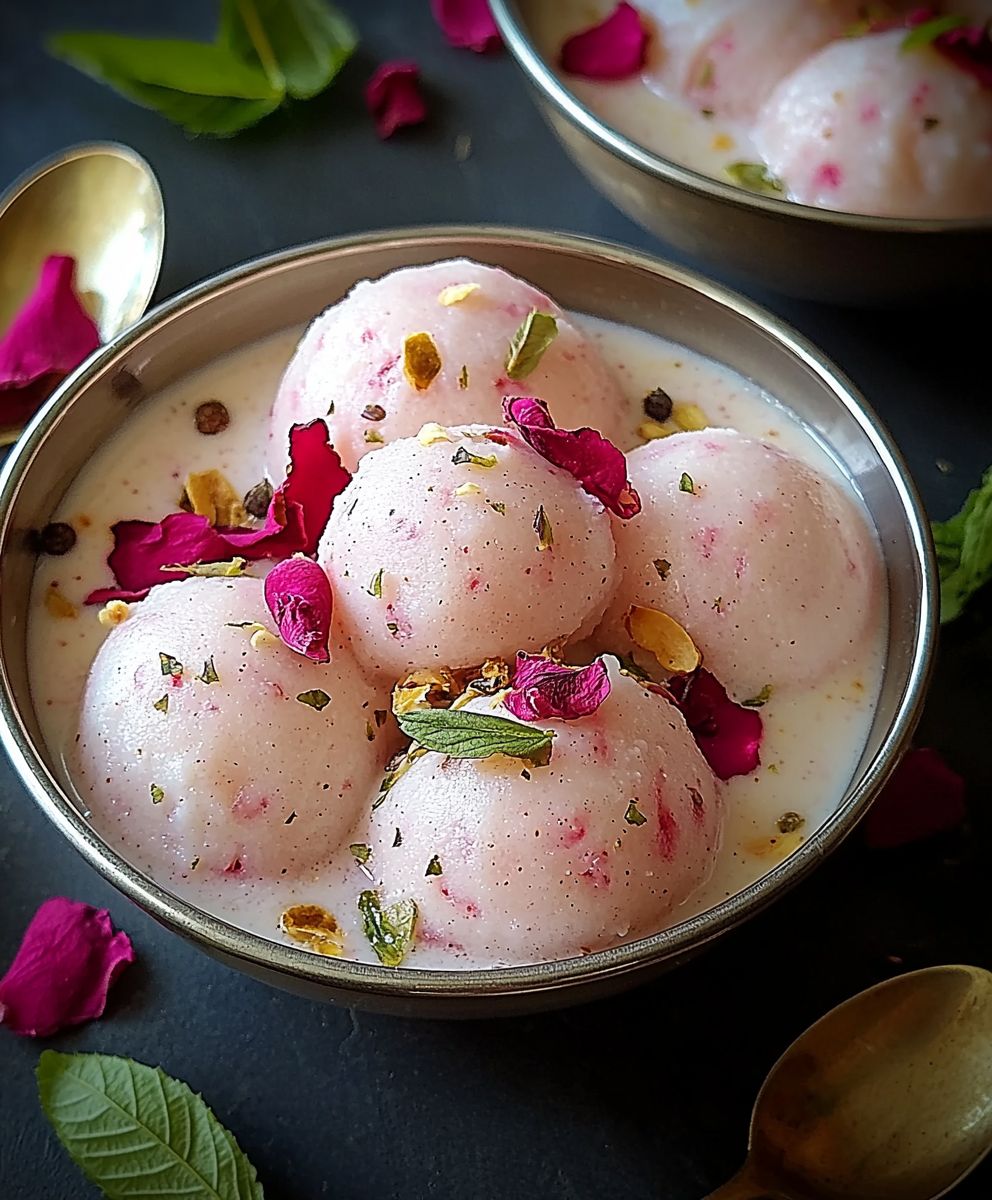
Conclusion:
And there you have it! This Rose Rasmalai recipe is truly a must-try, transforming a classic Indian dessert into something even more exquisite and unforgettable. The delicate rose flavor elevates the traditional milky sweetness, creating a symphony of textures and tastes that will leave you and your guests utterly captivated. I promise, once you taste this, you’ll understand why I’m so excited to share it with you. But why is this particular recipe so special? It’s the perfect balance of simplicity and sophistication. While it might seem intimidating at first glance, I’ve broken down each step to ensure even beginner cooks can achieve rasmalai perfection. The subtle rose essence isn’t overpowering; instead, it complements the richness of the milk and the delicate texture of the cheese patties, creating a harmonious blend that’s both comforting and refreshingly unique. Plus, the vibrant pink hue makes it a stunning centerpiece for any occasion. Serving Suggestions and Variations: This Rose Rasmalai is delicious served chilled, allowing the flavors to meld together beautifully. I personally love to garnish it with a sprinkle of chopped pistachios and a few dried rose petals for an extra touch of elegance. For a more decadent experience, try serving it with a scoop of vanilla ice cream or a dollop of whipped cream. Looking for variations? You can experiment with different types of nuts, such as almonds or cashews, for added texture and flavor. For a richer, creamier rasmalai, use full-fat milk and add a touch of heavy cream to the rabri. If you’re feeling adventurous, try incorporating a hint of cardamom or saffron for an even more complex flavor profile. You can also adjust the amount of rose water to your liking, depending on how pronounced you want the rose flavor to be. Another fun variation is to add a few drops of pink food coloring for a more vibrant and visually appealing dessert. Don’t be afraid to get creative and personalize this recipe to your own taste! The beauty of cooking is that it’s all about experimentation and finding what works best for you. Time to Get Cooking! I truly believe that this Rose Rasmalai will become a new favorite in your household. It’s perfect for special occasions, holidays, or simply as a delightful treat to brighten up your day. The combination of the familiar rasmalai texture with the unexpected rose flavor is simply divine. So, what are you waiting for? Gather your ingredients, put on your apron, and get ready to embark on a culinary adventure. I’m confident that you’ll be thrilled with the results. And most importantly, I want to hear about your experience! Once you’ve tried this recipe, please share your thoughts and photos with me. Did you make any modifications? What did your family and friends think? I’m always eager to learn from your feedback and see your own creative interpretations of this delicious dessert. You can leave a comment below or tag me on social media I can’t wait to see your Rose Rasmalai creations! Happy cooking! Print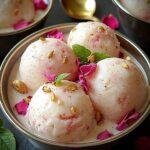
Rose Rasmalai: A Delightful Twist on a Classic Indian Dessert
- Total Time: 150 minutes
- Yield: 12–15 Rasmalai patties 1x
Description
Soft, spongy Rasmalai patties soaked in creamy, rose-infused rabri. This delightful Indian dessert blends textures and flavors, perfect for special occasions.
Ingredients
- 4 cups whole milk (full-fat is best!)
- 2 tablespoons lemon juice or white vinegar (for curdling)
- 1/4 cup all-purpose flour (maida)
- 1/2 teaspoon baking powder
- 6 cups whole milk
- 1/2 cup granulated sugar (adjust to taste)
- 1/4 teaspoon cardamom powder
- A pinch of saffron strands (kesar)
- 1 tablespoon chopped pistachios (for garnish)
- 1 tablespoon chopped almonds (for garnish)
- 1 teaspoon rose water
- 1/4 cup rose syrup (Rooh Afza or similar)
- Edible rose petals (for garnish, optional)
Instructions
- Curdling the Milk: Pour the 4 cups of whole milk into a large pot. Bring it to a boil over medium heat, stirring occasionally to prevent it from sticking to the bottom. Once the milk boils, reduce the heat to low.
- Adding the Acid: Gradually add the lemon juice or white vinegar, one tablespoon at a time, stirring gently after each addition. You’ll see the milk start to curdle and separate into solids (the chhena) and whey (the watery liquid). If it doesn’t curdle after 2 tablespoons, add a little more, but be careful not to add too much, as it can make the chhena tough.
- Separating the Chhena: Once the milk has completely curdled, remove the pot from the heat. Line a colander with cheesecloth or muslin cloth. Pour the curdled milk into the lined colander. This will separate the chhena from the whey.
- Washing the Chhena: Rinse the chhena under cold running water for a few minutes. This removes the sour taste of the lemon juice or vinegar and helps to stop the cooking process.
- Removing Excess Water: Gather the edges of the cheesecloth and squeeze out as much excess water as possible. Then, tie the cheesecloth into a bundle and hang it over a sink or bowl for about 30-45 minutes to drain completely. This is crucial for getting the right texture. You want the chhena to be moist but not wet.
- Kneading the Chhena: Once the chhena has drained, transfer it to a clean, flat surface. Now comes the important part: kneading! Use the heel of your hand to knead the chhena for about 8-10 minutes, until it becomes smooth and lump-free. This step is essential for making soft and spongy Rasmalai patties. If the chhena is too dry, sprinkle a little milk over it while kneading.
- Adding Flour and Baking Powder: Add the all-purpose flour (maida) and baking powder to the kneaded chhena. Mix well and knead again for another 2-3 minutes until everything is combined into a smooth dough.
- Shaping the Patties: Divide the chhena dough into 12-15 equal portions. Roll each portion into a smooth ball and then gently flatten it into a disc shape, about 1-1.5 inches in diameter. Make sure the edges are smooth to prevent them from cracking during cooking.
- Preparing the Sugar Syrup: In a wide, heavy-bottomed pan or kadhai, combine 4 cups of water and 1 cup of granulated sugar. Bring the mixture to a boil over medium heat, stirring until the sugar dissolves completely.
- Cooking the Patties: Once the sugar syrup is boiling, gently drop the chhena patties into the syrup, one at a time. Make sure not to overcrowd the pan. Cover the pan and cook the patties for about 15-20 minutes on medium heat. The patties will puff up and almost double in size.
- Checking for Doneness: After 15-20 minutes, gently check if the patties are cooked through. They should be soft and spongy. If they still seem dense, cook for a few more minutes.
- Cooling the Patties: Once the patties are cooked, turn off the heat and let them cool in the sugar syrup for at least 30 minutes. This allows them to absorb the syrup and become even softer.
- Gently Pressing the Patties: After cooling, gently press each patty between your palms to remove excess sugar syrup. Be careful not to squeeze them too hard, as they are delicate.
- Boiling the Milk: In a heavy-bottomed pan, pour the 6 cups of whole milk. Bring it to a boil over medium heat, stirring frequently to prevent it from sticking to the bottom.
- Simmering and Reducing: Once the milk boils, reduce the heat to low and let it simmer for about 45-60 minutes, or until it reduces to about half its original volume. Keep stirring occasionally to prevent it from sticking and to scrape off the milk solids that form on the sides of the pan. These milk solids are what give the rabri its rich texture.
- Adding Sugar and Cardamom: After the milk has reduced, add the 1/2 cup of granulated sugar and 1/4 teaspoon of cardamom powder. Stir well until the sugar dissolves completely.
- Adding Saffron and Rose Syrup: Add a pinch of saffron strands and the 1/4 cup of rose syrup (Rooh Afza or similar) to the rabri. Stir gently to combine. The saffron will add a beautiful color and aroma, while the rose syrup will give it a lovely rose flavor.
- Adding Rose Water: Stir in 1 teaspoon of rose water.
- Simmering Further: Continue to simmer the rabri for another 10-15 minutes, stirring occasionally, until it thickens slightly. The consistency should be creamy and slightly coating.
- Cooling the Rabri: Turn off the heat and let the rabri cool completely. As it cools, it will thicken further.
- Soaking the Patties in Rabri: Gently place the cooled Rasmalai patties into the cooled rabri. Make sure the patties are submerged in the rabri so they can soak up all the delicious flavors.
- Refrigerating: Cover the bowl and refrigerate the Rasmalai for at least 4-6 hours, or preferably overnight. This allows the patties to fully absorb the rabri and become incredibly soft and flavorful.
- Garnishing and Serving: Before serving, garnish the Rose Rasmalai with chopped pistachios, chopped almonds, and edible rose petals (if using).
- Serving Chilled: Serve the Rose Rasmalai chilled. Enjoy!
Notes
- Using full-fat milk is crucial for the best texture and flavor in both the chhena and the rabri.
- Be careful not to over-curdle the milk when making the chhena, as this can result in tough patties.
- Kneading the chhena well is essential for soft and spongy Rasmalai.
- Don’t overcrowd the pan when cooking the patties in sugar syrup.
- The rabri should be simmered on low heat to prevent scorching and to allow the milk solids to develop properly.
- Refrigerating the Rasmalai for at least 4-6 hours is necessary for the patties to fully absorb the rabri.
- Prep Time: 45 minutes
- Cook Time: 105 minutes

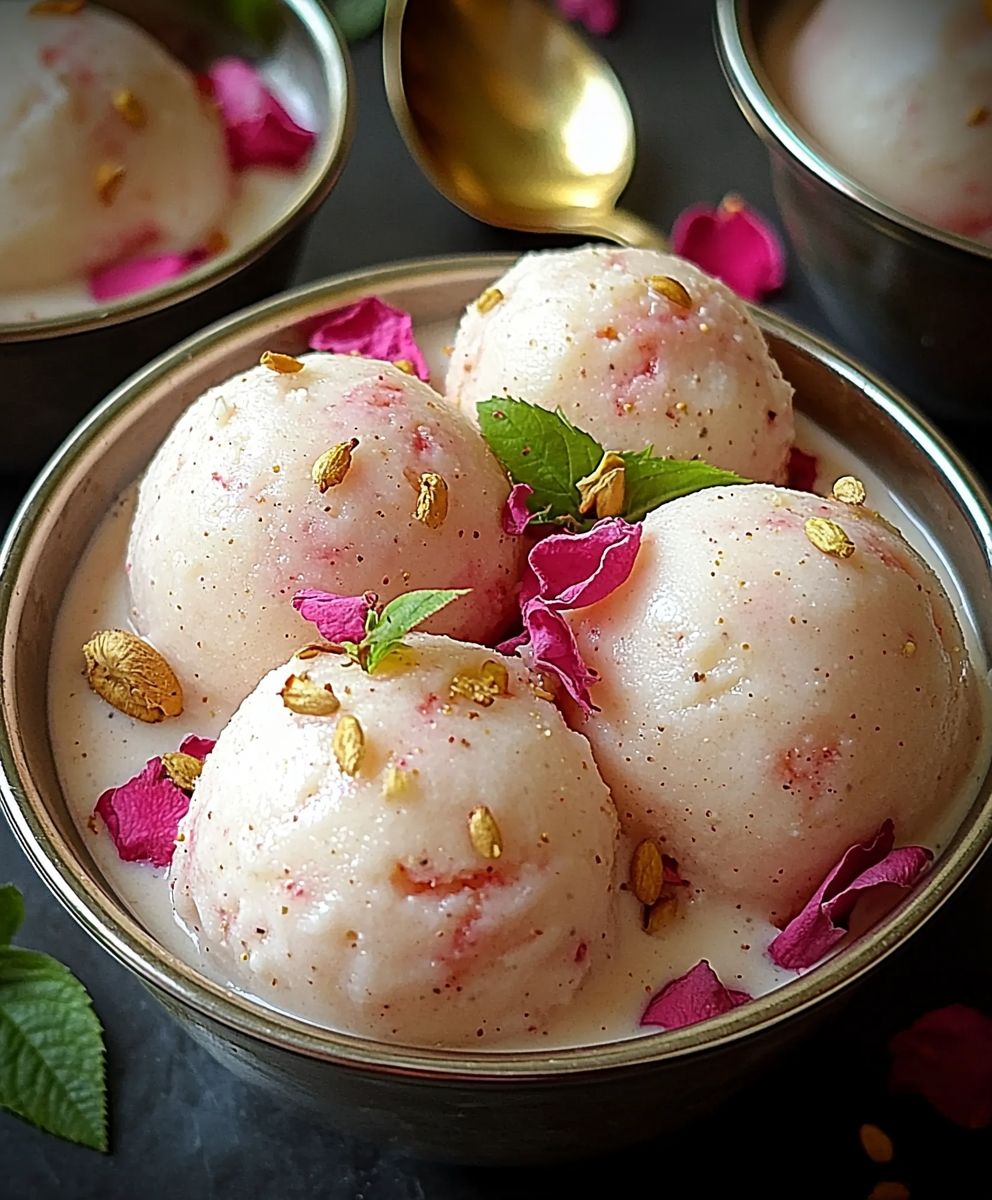
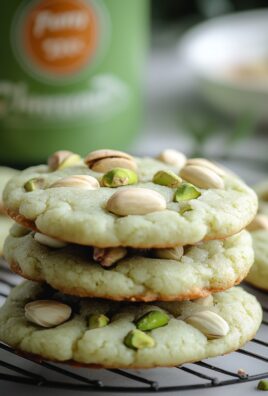
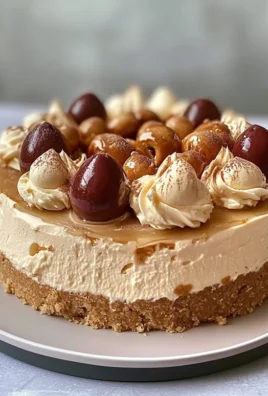
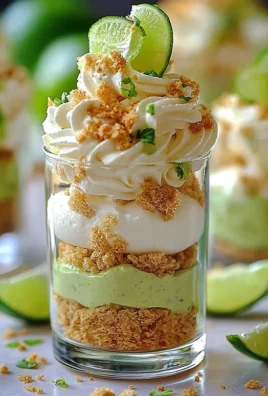
Leave a Comment